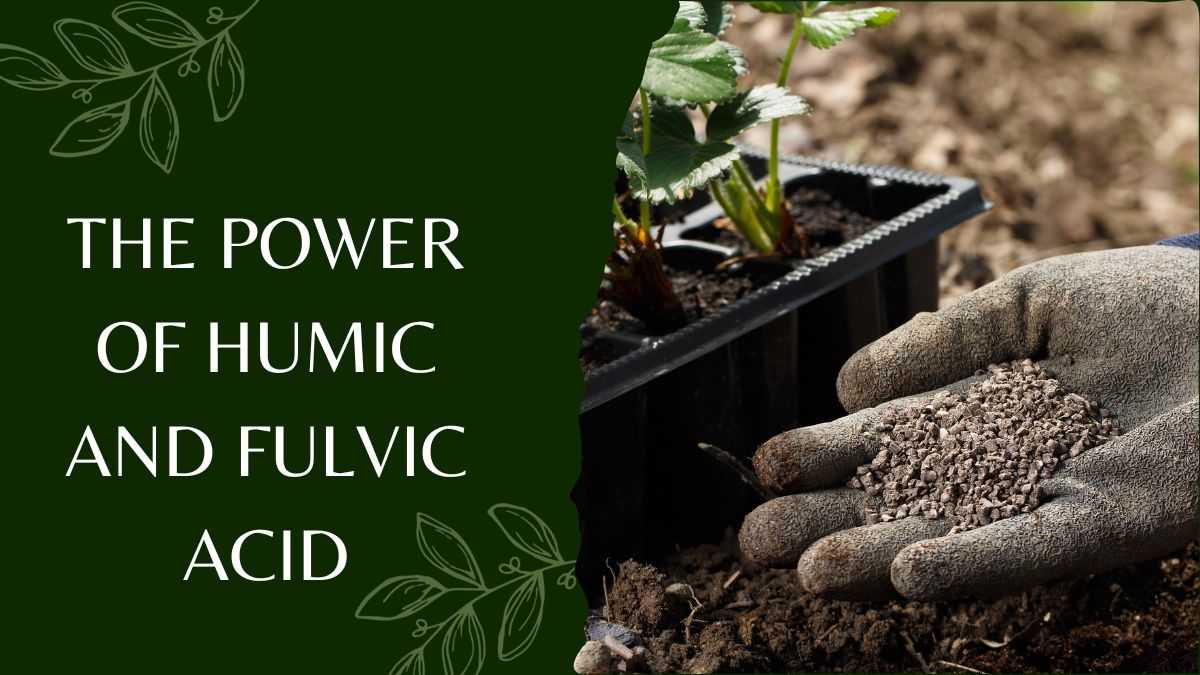Looking to unlock the secret of healthy, vibrant plants? Maximize plant growth with the power of humic and fulvic acid. These complex acids, naturally found in soil, play a crucial role in nutrient uptake and plant vitality.
By understanding the differences between humic and fulvic acid, you can optimize your growing conditions and witness remarkable results.
Combined, these acids increase water retention, stimulate microbial activity, and promote root and shoot growth. Discover the key to thriving plants and create a sense of belonging in your garden.
Key Takeaways
- Humic and fulvic acid have different molecular sizes and functions, with humic acids providing an optimal growing environment in soil and fulvic acids transferring vital nutrients through the cell membrane of plants.
- Both humic and fulvic acid are essential for healthy plants as they work together to increase water holding capacity, stimulate root and shoot growth, and facilitate the transfer of nutrients.
- Humin, a fraction of humic substances, improves soil water holding capacity and structure but is not considered as vital to plant health as humic and fulvic acid.
- Humic and fulvic acid can be applied in arable crop applications, tank mixed with fungicides or liquid nitrogen, to prevent nutrient immobilization and improve nutrient uptake by crops.
What Are Humic and Fulvic Acid
Humic and fulvic acids are complex organic compounds found in the soil. They’re released during the decomposition of plants and animals by bacteria.
Humic acids are larger molecules, while fulvic acids are smaller molecules. Humic acids provide an optimal growing environment in the soil and stimulate microbial activity, increase water retention, and promote root and shoot growth.
Fulvic acids, on the other hand, transfer vital nutrients through the cell membrane of plants, acting as effective chelating compounds. They can pass through cell membranes, carrying valuable micronutrients into the plant.
Both humic and fulvic acids are essential for healthy plants, working together to increase water holding capacity and stimulate growth.
The Difference Between Humic and Fulvic Acid
You can easily distinguish between humic and fulvic acids by understanding their unique molecular sizes and the different ways they function in plant growth.
Humic acids are large molecules with a molecular size ranging from 10,000 to 100,000, while fulvic acids are smaller molecules with a molecular size ranging from 1,000 to 10,000.
Humic acids are best applied in soil, providing an optimal growing environment by unlocking and binding nutrients, stimulating microbial activity, and promoting root and shoot growth.
On the other hand, fulvic acids work well in both soil and foliar applications. They transfer vital nutrients through the cell membrane of plants, acting as an effective chelating compound.
Molecular Weight and Composition
The molecular weight and composition of humic and fulvic acids play a crucial role in their solubility and functionality. Understanding these factors is essential for maximizing plant growth and harnessing the benefits of fulvic acid. Here are three key points to consider:
- Molecular Weight: Humic acids are larger molecules, while fulvic acids are smaller molecules. This difference in size affects their solubility and ability to penetrate plant cells.
- Composition: Both humic and fulvic acids are composed of carbon, oxygen, and hydrogen atoms. However, humic acids have a lower amount of oxygen compared to fulvic acids. This difference in composition affects their chemical behavior and solubility.
- Plant Growth: Fulvic acids, with their smaller size and higher oxygen content, are more soluble and readily absorbed by plants. They act as effective chelating compounds, binding to nutrients and facilitating their uptake. This promotes healthy plant growth and enhances nutrient availability.
Understanding the molecular weight and composition of humic and fulvic acids is crucial for optimizing their functionality and harnessing their benefits in plant growth.
Oxygen-Containing Functional Groups
You can enhance your understanding of humic and fulvic acids by examining the oxygen-containing functional groups present in them and how they affect their solubility and chemical behavior.
These functional groups greatly influence the solubility of humic and fulvic acids in water. Fulvic acids, with their abundant oxygen-containing functional groups, are soluble in water under all pH conditions. On the other hand, humic acids are only soluble in water under alkaline conditions.
The limited number of oxygen-containing functional groups in humic acids causes them to become more hydrophobic compared to fulvic acids, leading to precipitation in acidic environments. Understanding the differences in oxygen-containing functional groups helps explain why fulvic acids remain soluble while humic acids precipitate.
Solubility in Water
Both humic acids and fulvic acids have different solubility in water, with fulvic acids being soluble under all pH conditions and humic acids only being soluble under alkaline conditions. This difference in solubility plays a crucial role in their effectiveness and application.
Here are three important points to consider:
- Fulvic acids, being soluble under all pH conditions, can easily dissolve in water, allowing for easy absorption by plants. This solubility makes fulvic acids highly efficient in delivering vital nutrients to plants, enhancing their growth and development.
- On the other hand, humic acids require alkaline conditions to become soluble in water. This limited solubility restricts their availability for plants under acidic conditions. However, in alkaline environments, humic acids can unlock and bind nutrients in the soil, making them accessible for plant uptake.
- It’s important to be cautious when using fulvic acid, as there are potential dangers associated with its improper use. Fulvic acid supplements, when taken in excessive amounts, may lead to mineral imbalances and interact negatively with certain medications. It’s crucial to consult with a healthcare professional before using fulvic acid as a supplement.
Related Post: Discover the Hidden Healing Power of Fulvic Acid: A Breakthrough in Cancer Treatment.
Hydrophobicity and Precipitation
When using humic acids, it’s important to consider their hydrophobicity and potential precipitation, especially when adding them to highly acidic fertilizers.
Humic acids, with their limited numbers of oxygen-containing functional groups, become more hydrophobic compared to fulvic acids. This hydrophobicity can cause them to form aggregates and precipitate out of solution. This can be problematic, particularly when adding humic acids to highly acidic fertilizers, as it can lead to the clogging of spray nozzles.
On the other hand, fulvic acids, with their higher numbers of oxygen-containing functional groups, remain water soluble even at strongly acidic pH values. They don’t exhibit the same level of hydrophobicity and precipitation as humic acids.
Therefore, when using humic acids, it’s crucial to be mindful of their hydrophobic nature and the potential for precipitation, especially when combining them with highly acidic fertilizers.
Differentiation Based on Molecular Size
The differentiation between humic acids and fulvic acids isn’t determined by molecular size, but primarily by the amount of oxygen-containing functional groups they possess.
Imagine a cluster of humic acid molecules, with their large size ranging from 10,000 to 100,000. They’re dark in color and contain carbon chains, carbon rings, oxygen, nitrogen, hydrogen, and phosphorus. These molecules are soluble in alkaline solutions but not in water under acidic conditions.
Now picture a group of fulvic acid molecules, much smaller in size ranging from 1,000 to 10,000. They’re soluble in water at all pH levels and consist mostly of carbon, hydrogen, oxygen, and nitrogen. These molecules have the ability to pass through cell membranes, carrying vital micronutrients into plants.
Together, humic and fulvic acids work synergistically to optimize growing conditions. Humic acids unlock and bind nutrients in the soil, while fulvic acids transfer those nutrients into plants. They increase water retention, stimulate microbial activity, and promote root and shoot growth. Using both acids is vital for healthy plant growth and nutrient uptake.
Benefits of Humic and Fulvic Acid
You can experience numerous benefits by incorporating humic and fulvic acids into your plant growth regimen. These acids play a vital role in promoting healthy plant growth and nutrient uptake.
Humic acids, with their large molecular size, unlock and bind nutrients in the soil, making them readily available for plant uptake. They also stimulate microbial activity, increase water retention, and promote root and shoot growth.
Fulvic acids, on the other hand, are smaller molecules that transfer vital nutrients through the cell membrane of plants. They act as carriers for nutrients and can pass through cell membranes, carrying valuable micronutrients into the plant.
When used together, humic and fulvic acids optimize growing conditions, increase water holding capacity, and stimulate root and shoot growth. Incorporating these acids into your plant growth regimen can greatly enhance the health and productivity of your plants.
Application of Humic and Fulvic Acid
To maximize the benefits of humic and fulvic acids, consider incorporating them into your plant growth regimen and applying them in combination with fertilizers or sprays. Here are three key considerations for using humic and fulvic acids in your plant care routine:
- Synergistic Action: When used together with fertilizers or sprays, humic and fulvic acids work in harmony to improve nutrient uptake and availability. Humic acids unlock and bind nutrients in the soil, while fulvic acids facilitate the transfer of these nutrients through the cell membrane of plants. This synergistic action ensures that your plants receive the essential nutrients they need for optimal growth.
- Versatile Application: Humic acids are best applied in soil, whereas fulvic acids are effective in both soil and foliar applications. This versatility allows you to tailor your approach based on the specific needs of your plants. Whether you choose to incorporate humic acids into the soil or use fulvic acids for foliar sprays, both acids contribute to enhanced plant health and growth.
- Increased Water Retention: Humic and fulvic acids also improve water retention in the soil, promoting a healthier growing environment for your plants. By increasing the water holding capacity, these acids help ensure that your plants have access to adequate moisture, even during periods of drought or water scarcity.
Potential Effects on Soil Biology
Adding humic and fulvic acids or molasses can potentially enhance soil biology by providing a carbon source to energize the microbiology in the soil. These substances act as food for the microorganisms, stimulating their activity and promoting a healthy soil ecosystem.
Research suggests that the addition of humic and fulvic acids can reduce the negative impact of fertilizers and pesticides on soil biology. By providing a carbon source, these acids can help to counterbalance the potential harmful effects of these chemicals.
However, it’s important to note that limited research exists on the effectiveness of this theory, and more studies are needed to fully understand the true impact on soil biology. Nonetheless, incorporating humic and fulvic acids or molasses into soil management practices may contribute to a more sustainable and thriving soil environment.
Frequently Asked Questions
How Are Humic and Fulvic Acids Released Into the Soil?
Humic and fulvic acids are released into the soil through the decomposition of plants and animals by bacteria. This natural process allows these complex acids to aid nutrient uptake by binding with minerals and transferring them to plants.
Can Humic and Fulvic Acids Be Applied as Seed Coatings?
Yes, humic and fulvic acids can be applied as seed coatings. This application method can enhance seedling root growth and germination in various crops, especially in challenging seedling growth conditions.
Are There Any Potential Negative Effects of Using Humic and Fulvic Acids on Soil Biology?
There may be potential negative effects on soil biology when using humic and fulvic acids, but more research is needed to determine the true impact. It’s important to consider the health of the soil and conduct trials to evaluate the effects.
How Do Humic and Fulvic Acids Affect Nutrient Uptake in Plants?
Humic and fulvic acids enhance nutrient uptake in plants. Humic acids unlock and bind nutrients in the soil, while fulvic acids transfer those nutrients through the cell membrane, optimizing plant growth.
Are There Any Specific Crops That Have Shown Significant Benefits From the Application of Humic and Fulvic Acids?
Certain crops, such as seedlings and arable crops, have shown significant benefits from humic and fulvic acid application. These acids improve nutrient uptake, combat challenging growth conditions, and can be applied as seed coatings for optimal results.
Conclusion
To maximize plant growth and unlock the secret to healthy plants, harnessing the power of humic and fulvic acid is key. These complex acids play a crucial role in nutrient uptake and plant vitality. By understanding the differences between humic and fulvic acid, you can optimize your growing conditions.
Did you know that using both humic and fulvic acid together can increase water retention, stimulate microbial activity, and promote root and shoot growth? Incorporating these acids into your plant care routine can lead to thriving and vibrant plants.




